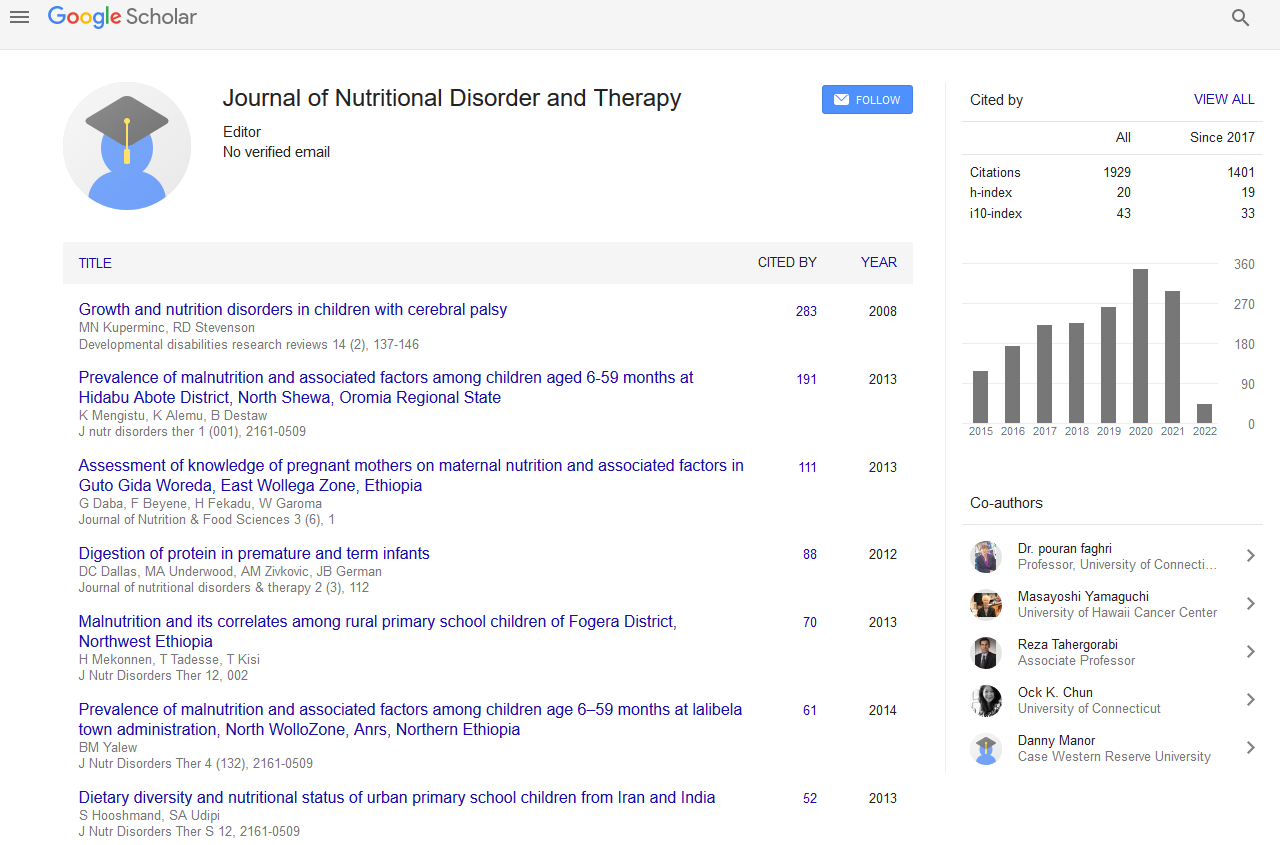Indexed In
- Open J Gate
- Genamics JournalSeek
- Academic Keys
- JournalTOCs
- Ulrich's Periodicals Directory
- RefSeek
- Hamdard University
- EBSCO A-Z
- OCLC- WorldCat
- Publons
- Geneva Foundation for Medical Education and Research
- Euro Pub
Useful Links
Share This Page
Journal Flyer

Open Access Journals
- Agri and Aquaculture
- Biochemistry
- Bioinformatics & Systems Biology
- Business & Management
- Chemistry
- Clinical Sciences
- Engineering
- Food & Nutrition
- General Science
- Genetics & Molecular Biology
- Immunology & Microbiology
- Medical Sciences
- Neuroscience & Psychology
- Nursing & Health Care
- Pharmaceutical Sciences
Detox and metabolism practical orthomolecular and nutritional approach
JOINT EVENT: 13th International Congress on Advances in Natural Medicines Nutraceuticals & Neurocognition & 14th International Conference on Clinical Nutrition
July 27-29, 2017 Rome, Italy
Roni Moya
CESPU University, Portugal
Posters & Accepted Abstracts: J Nutr Disorders Ther
Abstract:
One of the main health problems of the contemporary life and a mandatory concern to all antiaging physicians is the outcome of the constant contact with the high level of intoxication, which can be connected to the wide range of diseases, from allergies till cancer or neural degeneration. Discussion of the physiological pathways for detoxification has been mainly centered on phase I and phase II enzyme systems. Some key nutrients and antioxidants substances, which can inhibit the oxidation of a molecule and have the capacity to nullify the ill effects of oxidation caused by free radicals in the living organisms, have been and continue to be investigated for their role in the modulation of metabolic pathways involved in detoxification processes. Superoxide dismutase (SOD), glutathione peroxidase (GPX) and catalase are the key enzymatic antioxidants of this defense system by which the free radicals that are produced during metabolic reactions are removed. Several publications to date have leveraged cell, animal, and clinical studies to demonstrate that within the correct dose and synergy, food-derived components and nutrients can function as important co-factors to modulate processes of conversion and excretion of toxins from the body. The �??Phase I�?� Cytochrome P450 CYP450 superfamily of enzymes is generally the first defense employed by the body to bio transform xenobiotic, steroid hormones, and pharmaceuticals. This microsomal membrane bound, hemethiolate proteins, located mainly in the liver, but also in enterocytes, kidneys, lung, and even the brain, are responsible for the oxidation, peroxidation, and reduction of several endogenous and exogenous substrates. It is accepted that any variability in the number of CYP450 enzymes could have benefit(s) and/or consequence(s) for how an individual responds to the effect(s) of (a) toxin(s). Many nutrients appear to act as both inducers and inhibitors of CYP1 enzyme. These findings indicate that specific foods, vitamins, minerals, enzymes, etc., may upregulate or favorably balance metabolic pathways to assist with toxin biotransformation and subsequent elimination. Various foods such as cruciferous vegetables, berries, soy, garlic, turmeric and other spices, plus probiotics and exogenous antioxidants such as vitamins C, E, B complex, glutathione, cysteine, taurine, methionine, L-carnitine, CoQ10, etc., have been suggested to be beneficial and commonly prescribed as part of the orthomolecular and functional medicine based therapies. The objective of this talk is to highlight the clinical effect of the orthomolecular nutrients in the DE intoxication mechanisms. Enhance the knowledge about the main antioxidants, foods and their individual phytonutrients, especially in the case of dietary supplements and functional foods, could be worthwhile for clinicians to consider for patients who are taking a polypharmacy approach or are in contact with pollution by-products, heavy metals, hormones and further xenobiotic.


